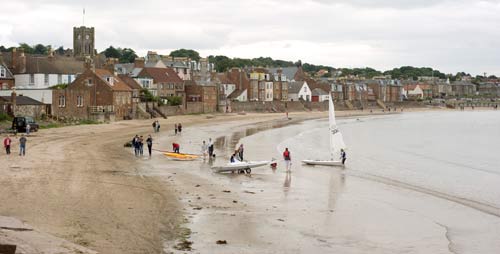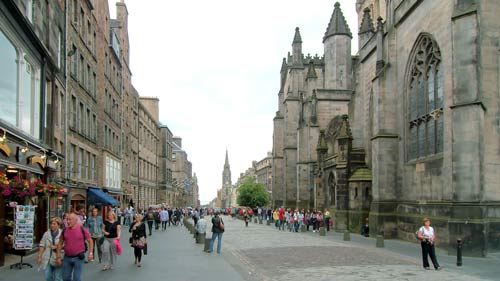
A Short Break
We drove to Edinburgh recently for a short break and to take some photographs for our ecard collection. So we were armed with maps and a guidebook and I took my main camera (a Nikon D700) and a Panasonic LX3.
We live in West Yorkshire, and according to Google Maps the journey should take four-and-a-half hours.
Well, Edinburgh is 200 miles from Leeds so that’s an average of just 45 miles per hour. Something didn’t add up, but I didn’t really think about it until we were in the Scottish border area when the reason became clear.
Although we were traveling along the A1 – a major arterial highway – it was just one lane each way for large parts of the journey through the Scottish countryside.
The A1 runs all the way from London, and for practically the whole length of England it is two or even three lanes in each direction. So just one lane each way in Scotland is remarkable.
For an island like Britain that is crisscrossed with roads, this was a major revelation. I really felt we were slowing down to a more relaxed and pleasant pace just by traveling on a one-lane highway. Scotland began to feel like the country at the end of the rainbow.
Drama All Around
When one lives in a place day to day perhaps it is easy to forget the backdrop of the town or city as one crosses the road, catches a bus, or goes shopping. As a visitor to Edinburgh, however, it is almost impossible not to be constantly aware of the drama of the place.
A Little Bit Of Background
Edinburgh is 56° north of the Equator, which puts it at about the same latitude as Copenhagen and Moscow.
In the three full days we were there, it rained on the first day, was bright and sunny the next day, and then on the third day the weather became overcast – as though the sky had been rubbed with a bluish-grey grit. That cold, overcast sky is reminiscent of a typical sky in Leeds, and is not my favorite kind of weather.
There is, however, a lively bustle about Edinburgh – all played out against the fine architecture – so the overcast weather was bearable.
Day Length
Because the Earth is tilted on its axis relative to the sun, places far from the equator have a more variable day length throughout the year. The summer days in Edinburgh are very long and so we had sixteen-and-a-half hours of daylight to enjoy.
That’s the good news. The bad news is that in the dead of winter Edinburgh only gets about seven-and-a-half hours of daylight.
But thanks to the warming effect of the Gulf Stream, it does not get as cold in winter as either Copenhagen or Moscow with which it shares the same latitude.
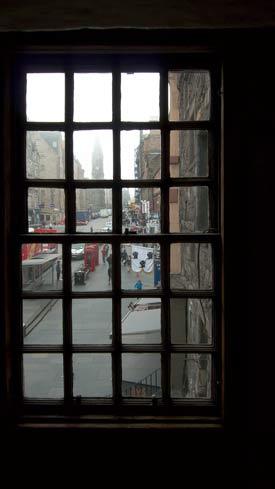
First Impressions
The center of Edinburgh is built along a narrow-sided valley that is just a couple of hundred yards across.
It would be romantic if a river ran along the bottom of the valley – it would be the icing on the cake. In fact, there is the railway station with the railway lines snaking away, so it is the glass roof of the station that fills most of the valley bottom.
Along one bank of the valley runs a series of tree-filled parks and behind them and higher up, runs Princes street, the main shopping street. Behind that are the ‘newer’ classical buildings laid out in fine terraces and crescents.
Behind that is the Scottish countryside. It is amazing that from some of the higher vantage points of the city center one can see beyond the built-up area to the rolling hills beyond. It made me feel that the place was friendly and manageable – perhaps because I don’t like long and arduous journeys just to get out of a city.
The Other Side Of the Valley
Across the narrow valley and parallel to Princes Street, runs the older, medieval drama of High Street that sits on a ridge that runs up to Edinburgh Castle.
The castle itself sits on the plug of a long-extinct volcano and below the castle walls there are the huge, sheer sides of the rock face. The sheer bulk of the castle marks a very dramatic end to the run of High Street.
The architecture of High Street dominates the skyline of Edinburgh with tall, solid, six-storeyed, granite buildings.
Seen from Princes Street, High Street look medieval, massive, looming, austere, and dour.
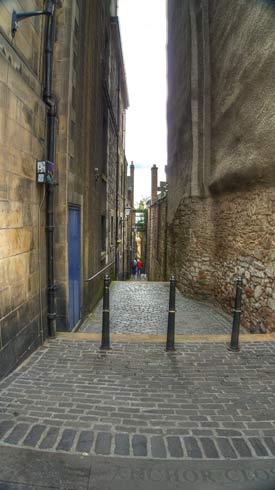
The buildings on the High Street seem to have been designed rather than to have simply grown together organically over the centuries. The strength of the architecture and the sheer scale of it is so great that when we passed it on the bus, it stopped me dead.
The architecture is in contrast to the large number of trees and green expanses of parkland lining the valley, to the friendly and appealing people, and to the cafe culture.
The city is busy, but not busy like London for example.
With a population of 450,000 Edinburgh is small as cities go, and very small as capital cities go. But there is a hum of people and tourists, and it does not feel far from civilization, as it might bearing in mind that it is a long day’s drive to London and further to continental Europe.
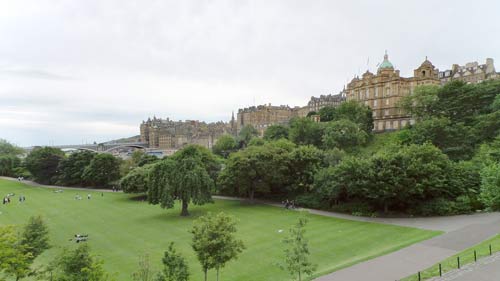
The People
Is it possible to form a view of people after just a day or two? With that caution, they seemed open, ready to talk, ready to listen and interested in other people rather than just in themselves. There was a kind of frankness in people’s faces that was easy to respond to warmly.
The tone of the goings-on in the town and the constant backdrop of the architecture and the hills behind, gives the place a distinct feel that probably goes some way to explaining Edinburgh and Scotland.
As there is usually the skirl of bagpipes from somewhere or other, it is easy to somehow tune the city to the haunting background melody of the bagpipes.
Outdoor Cafes
There are outside cafes everywhere, reminiscent of Europe rather than of neighbouring England.
Along with the cafes, there are skittish herring gulls with pale pink legs and large webbed feet, looking nervously around with their beady eyes and picking up scraps of food. They pick up scraps from the ground around the tables – and occasionally land on the tables in bold moves to grab something tasty.
They fly in from the sea that is just a couple of miles away because Edinburgh is on the south shore of the Firth of Forth, a broad river mouth that gives out into the open sea just a few miles to the east.
Outside Edinburgh
On our way back home we decided to take the coast road for a while.
So on leaving the city, we followed the road east along the coast to the village of North Berwick. Here, just a couple of miles offshore lies the world-famous Bass Rock.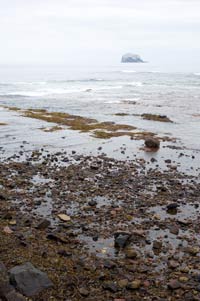
It is a tiny, steep-sided island just a couple of miles across. Like Edinburgh Castle, it is volcanic plug from a long-extinct volcano. It is also the home to the largest breeding colony of gannets in the world and to huge colonies of puffins, kittiwakes, razorbills, and guillemots.
Sir David Attenborough has described Bass Rock as one of the wildlife wonders of the world.
From a distance, the top of Bass Rock is one mass of white from the packed bodies of the nesting gannets. Even from the shore and with the naked eye, the top of the rock looks white, especially when the sunlight falls on it, as it did late in the afternoon when we were there.
There are boat trips out the Bass Rock and to the nearby Isle of May – the whole of which is a national nature reserve – organized by the Scottish Seabird Center and I have made a note that taking a trip out to one or other of these islands is something I hope to do soon.
For those who might want to take a trip organized by the Scottish Seabird Center, you might be interested to note that it describes itself as “…a charity dedicated to inspiring people to appreciate and care for wildlife and the environment.”
